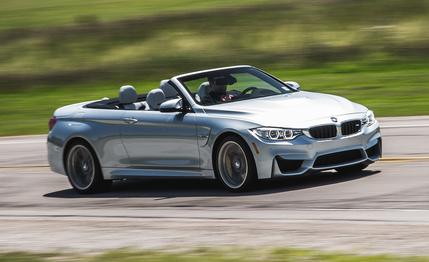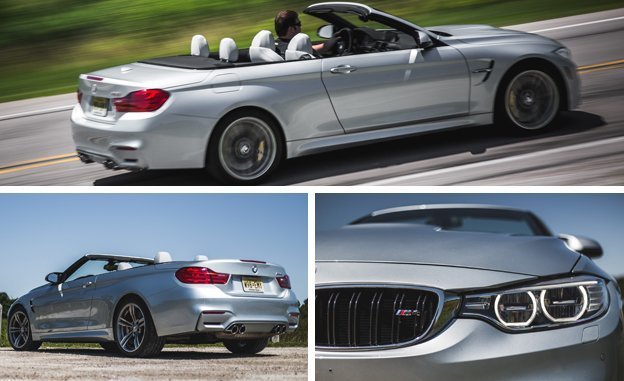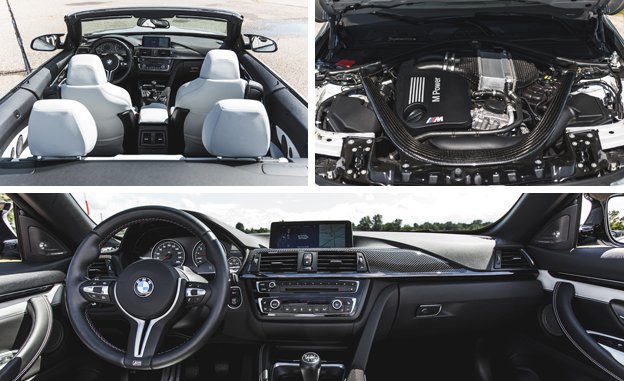 Instrumented Test
Instrumented Test
As the E92 BMW M3 was carving out its place in history, BMW’s self-appointed arbiters of purity immediately branded its optional sunroof the mark of a poseur. The sunroof precluded the carbon-fiber roof panel, which meant not only more weight but more weight higher up, thus raising the center of gravity. And any true M3 pilot acid-dips his helmet and goes shirtless on track days to achieve the lowest possible center of gravity.
By that thinking, the convertible is the bastard child of the M3/M4 family. Convertibles invariably weigh more than the coupes on which they’re based, but they don’t invariably weigh 14 percent more. Yet that’s the gain that this 4041-pound convertible represents over a similarly outfitted M4 coupe. A 485-pound weight gain is more what we’d expect when making a convertible out of a Chevrolet Tahoe. (Why not a Suburban, you ask? Because the proportions would be all wrong.) However, there is one bright spot in the M4 droptop’s weight gain—optimized distribution of the extra pounds. Whereas the coupe carries 52 percent of its weight over the front wheels, the complex mechanism that folds and stows the three-piece metal top shifts the weight bias rearward, to the point that 52 percent of the convertible’s weight is riding on the rear Michelins.

That mechanism is certainly responsible for a lot of the extra pounds, as is the roof itself. And then there’s all that structural bracing. Cut the top off, and you have to stiffen the remaining tub. In the M4’s case, they should have stiffened it even more. With the top down, a wholly un-M level of cowl shake takes over the M4. The sturdy top lessens the quivering when raised, but even then hidden bits emit rattles.
But not even an extra quarter-ton dulls the 425-hp straight-six’s enthusiasm. It still accelerates as though its torque curve were brick-shaped, with a vertical line at 1850 rpm making a 90-degree turn at 406 lb-ft and proceeding to the redline with nary a divot. The convertible matched the aforementioned, manual-transmission coupe at 4.1 seconds to 60 mph. They were even through the quarter-mile, too, at 12.4 seconds, although the convertible tailed by 4 mph. So drag racers, stick with the hardtop.
Dropping the top is the best way to listen to the blatty rip from the twin-turbo six’s quad tailpipes. As we’ve done with a handful of these cars now, we pulled up the trunk floor liner and removed the fuse for the sound-enhancing function, cutting the artificial flourishes BMW pipes through the audio speakers for a purer exhaust note.

Its weight may not slow down the convertible in a straight line, but it starts to have an impact when the road bends. We hit just 0.94 g on the skidpad—compared with 0.98 for the coupe—but, even if it doesn’t grip as tenaciously and is less willing to change direction, the convertible retains the M4’s characteristic tail-happiness and is still a near-perfect drift tool, particularly given the twin-turbo six’s fat lot of torque.
The M4 convertible’s sticker is equally swollen. At $73,495 to start, it wallops your wallet to the tune of $8300 over the coupe. A healthy options tab—including carbon-ceramic brakes, adaptive suspension, 19-inch wheels, and a bunch of luxury trimmings—pushed this example to $90,670. An M4 convertible could be optioned up to $100,000. Enough M4 goodness remains in the convertible that we still enjoy it in spite of its compromises, but at more than $90,000, it does get harder to love.